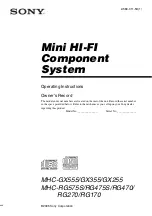
16
XONE:32
User Guide
Filter Type
Select the
FILTER TYPE
you want to use. Three
switches with LEDs select which type is active. You can
press any combination together to create different
response types such as ‘notch’ and an interesting ‘all-
pass’ effect. The switches are ‘soft switched’ for live
performance, meaning that the audio signal is ramped
between filter states to prevent audible clicks. The
selected type affects both X and Y filters.
Note that the last selected type is lost when power is
removed from the console. The LPF is always selected
when power is applied. However, you can store the
current selection in the
DRS™
user presets for instant
performance recall.
The graphs here show the effect on the audio frequency
response for the three filter types. The range of sweep
from low to high frequency is shown together with the
effect of adjusting RESONANCE (one frequency with
several resonance settings shown).
The vertical scale shows the amount of cut or boost
around the normal 0dB operating level. The horizontal
scale shows the change in frequency from low (bass) to
high (treble).
HPF
. Press this switch to select the high-pass filter.
Frequencies below the cut-off point are removed. The
cut-off point is adjusted using the VCF slider control or
modulated using the LFO. At low end little effect is
heard as only sub bass frequencies are removed.
Sweep higher to gradually remove the bass line followed
by the higher frequencies. The highest frequency is
limited to 10kHz as little useful material is heard beyond
this. TIP - Try switching the HPF in with VCF set at
highest frequency, then gradually sweeping the
frequency back to minimum. This can create an
atmosphere of anticipation as the dance floor awaits the
power of the beat to kick in.
BPF
. Press this switch to select the band-pass filter.
Frequencies above and below the cut-off point are
removed leaving just a narrow band of sound. Sweep
the VCF slider around its mid position to affect lead
sounds such as keyboard and vocals. TIP - Try picking
out individual sounds such as vocals and mixing them
into the beat and bass of the opposite track to create a
whole new mix. Add a little resonance to the BPF to lift
the sound out of the mix.
LPF
. Press this switch to select the low-pass filter. Frequencies above the cut-off point are removed. The cut-
off point is adjusted using the VCF slider control or modulated with the LFO. At minimum only sub bass
remains. Sweep higher to gradually introduce the bass line followed by higher frequencies into the mix. TIP -
Try sweeping the LPF back to a low setting to keep the beat and energy going while talking over the mix. Try
also punching in the filter and sweeping it back from high to low in time with the beat. Punch it out at the start of
the next bar.
In addition to the three basic filter types you can experiment with new effects by selecting combinations of
switches together. Press and release the switches together. They illuminate to show which filter types are
active. For example:
HPF+LPF
=
NOTCH
. Used with low settings of RESONANCE you get a phasing effect. Try sweeping the
effect across the frequency range.
HPF+BPF+LPF
=
ALL PASS
. A surprising effect considering that all frequencies are ‘passed’. However, the
filter type interaction around the cut-off point creates an interesting effect that varies from subtle to dramatic
depending on the RESONANCE setting.
10k
20
1kHz
100
20k
0dB
+ 5
+ 10
+ 15
+ 20
-5
-10
-15
-20
LO-PASS FILTER
LO
HI
BAND-PASS FILTER
LO
HI
10k
20
1kHz
100
20k
0dB
+ 5
+ 10
+ 15
+ 20
-5
-10
-15
-20
10k
20
1kHz
100
20k
0dB
+ 5
+ 10
+ 15
+ 20
-5
-10
-15
-20
HI-PASS FILTER
LO
HI
Содержание Xone:32
Страница 1: ...USER GUIDE Publication AP4264 P R O F E S S I O N A L D J M I X E R ...
Страница 24: ......
Страница 25: ...Check out my Internet site http www xone co uk ...










































